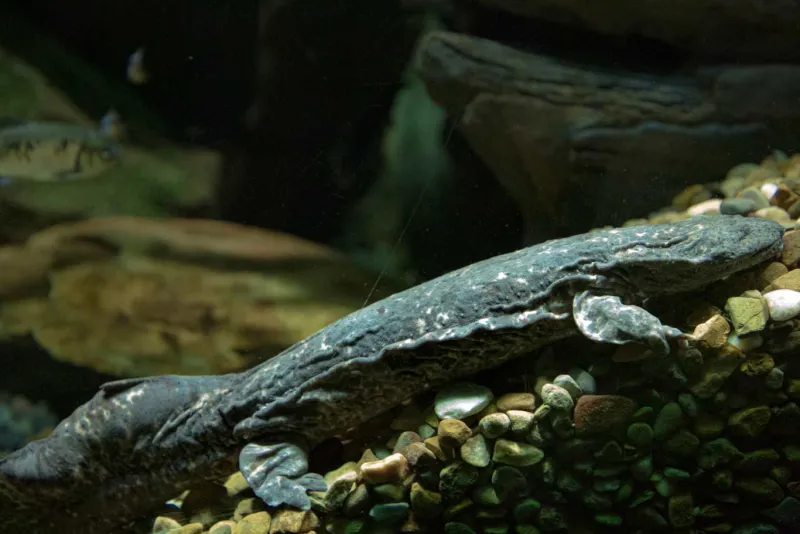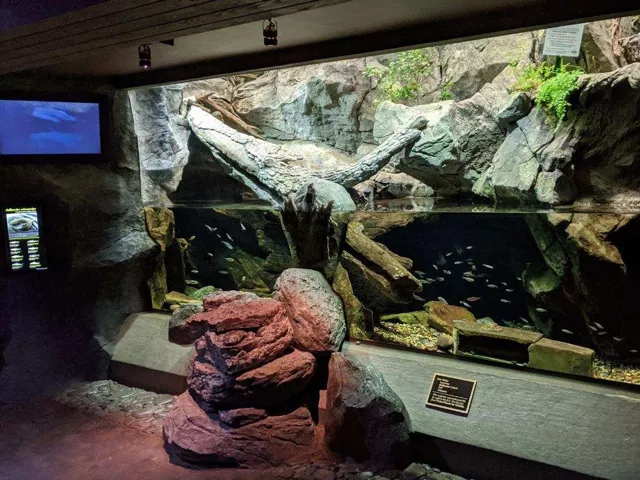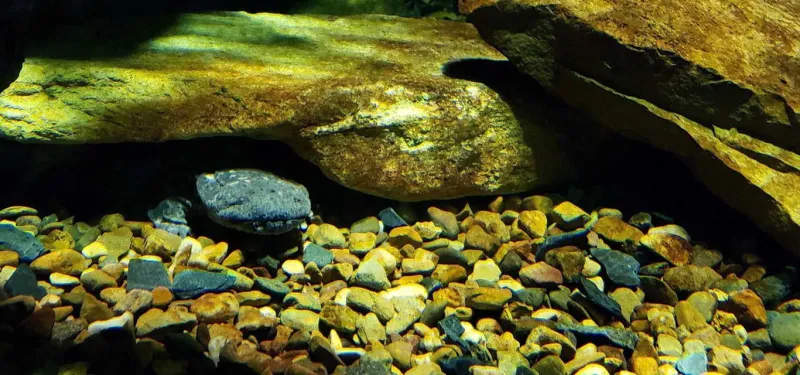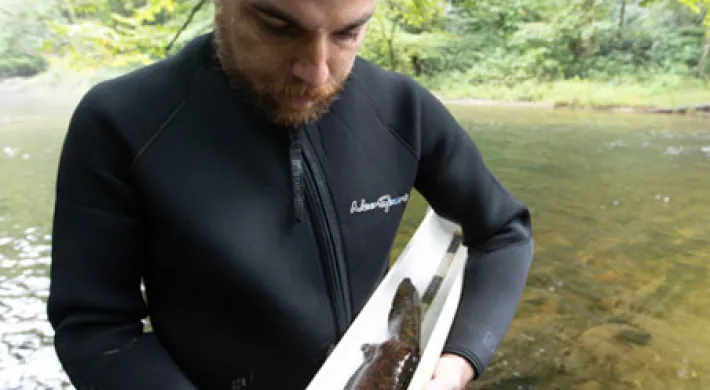Written by Katherine Hagen, Animal Management Supervisor
Two years ago, on May 8, 2018, the North Carolina Zoo held an opening event for the Hellbender habitat at the Streamside complex. And while designing this habitat was an opportunity to showcase these mysterious amphibians for our guests, it was by no means our introduction into caring for Hellbenders.
The eastern hellbender salamander, Cryptobranchus alleganiensis, has been an integral part of the North Carolina Zoo's conservation story for some time now. Keeper and curator staff have assisted the NC Wildlife Resources Commission in carrying out hellbender population surveys since 2007. Additionally, we've had a long-lived hellbender in our care for more than 25 years! This animal has served as an ambassador for the species over the past two decades. Still, the opening of our newly-renovated habitat in 2018 finally gave him the perfect environment.

North Carolina Zoo's largest resident Hellbender, has called Streamside home since 1994
With the opening of the updated habitat in 2018, we brought in four additional hellbenders (from two other zoos' breeding programs) in hopes of having two or more living in a habitat together, a concept that seems very straightforward! However, the humble hellbender has several characteristics that make this a more difficult undertaking than you might ever imagine.
Let's consider three of those natural history traits:
First, social distancing comes naturally to hellbenders! They spend most of their lives alone, only interacting with others of their species during the fall breeding season. Pairings between males and females last no longer than the time it takes a female to lay her 200-400 eggs for external fertilization.
So, they are solitary animals… goes hand in hand with having multiple individuals on habitat together, right?!
To accommodate this aspect of a hellbender's life, we needed a habitat that could hold more than one hellbender while respecting their social distancing preferences. You'll notice the habitat looks like one large system, and it functions that way from a filtration perspective, but it's been physically partitioned into two separate sides, to allow for a solitary hellbender to live on each side. The large, hollow log structure built by our Exhibit Design department provides the physical separation required for the salamanders. It has two layers of mesh on its interior to allow the resident fish to pass back and forth freely.

Hellbender Habitat in Streamside
Next, let's consider that hellbenders are nocturnal-- they're primarily active at night. However, our guests are diurnal (active during the day), and only visit us during daylight hours. Hellbenders are night owls, out and about when no one is around to see what they're up to…
To tackle the challenge of having nocturnal animals visible during the day, we darkened the guest area. We illuminated the habitat strategically, providing rock cover and darkened spaces as a refuge. The animals are also keen to perk up for a meal whenever a keeper shows up with food.
However, feeding hellbenders is a little unusual. Given that they are ectothermic (they do not generate their own body heat), hellbenders metabolisms function at the ambient water temperature of about 67 degrees. And because of this, they do not require energy (calories) on a daily basis!
Our largest hellbender typically eats once a week, while our smaller hellbenders may eat once or twice per week.
Hellbenders primarily feed on crayfish in the wild, but in our zoo setting, we offer a variety of fish, nightcrawlers, and occasionally pinky mice.
Circling back to our original goal of showcasing the hellbender at Streamside, we had to consider the minor fact that hellbenders pretty much look like rocks! They spend much of their lives on the rocky streambed, snugly sheltered under a broad, flat boulder with perhaps a portion of their head peeking out. They also rely on their cryptic coloration, their skin mottled with grays and browns, to blend in perfectly with their surroundings, avoid predators, or ambush a prey item that may creep past.
They blend in flawlessly with their surroundings. This is a camouflage challenge for our guests - find the hellbender with this in mind!
Remember, hellbenders prefer sticking low down at the streambed and like to hang out under a sizeable flat rock. So, spend some time perusing the bed of our habitat, pay close attention to what may be under the shelter rocks, and hopefully, you'll notice a face (or two!) cautiously peeking out at you! If you see a keeper, feel free to ask us for a hint but here's a photo to give you an idea of what you may be looking for when viewing the habitat.
To recap, hellbenders live alone, under rocks. They look like rocks and don't like to come out from under their rock until the cover of night. Quite the challenge for having cohabitating and visible hellbenders at the North Carolina Zoo! However, we love sharing these awesome creatures with our guests, and we've made many efforts to increase your chances of spotting one.
The eastern hellbender salamander is one of the largest, yet least known salamanders native to North America. And you can see one, or two, or maybe three - depending on how closely you look - the next time you visit the Streamside habitat complex.

Hellbender hiding under a rock in the Streamside habitat

